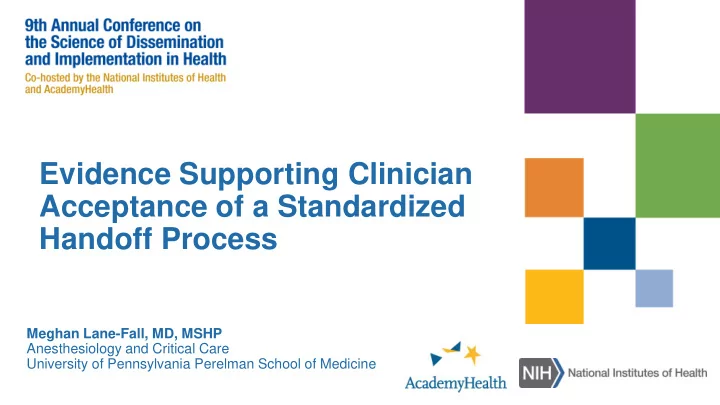

Evidence Supporting Clinician Acceptance of a Standardized Handoff Process Meghan Lane-Fall, MD, MSHP Anesthesiology and Critical Care University of Pennsylvania Perelman School of Medicine
• No conflicts of interest Financial disclosures • Funding sources: Anesthesia Patient Safety Foundation Robert Wood Johnson Foundation NIH-NHLBI PRIDE Research in Implementation Science for Equity
• Handoffs are transfers of Handoffs in patient care responsibility hospitals are • When handoffs go poorly, problematic patients experience preventable harm • Two major types of handoffs: Shift-to-shift handoffs Transitions in care
ICU provider surgeon OR to ICU handoffs are a type of transition in care anesthetist ICU nurse
Standards • At least 15 studies show improve improvement with OR to ICU standardization: handoffs Increased information exchange Better team functioning Improved short-term patient outcomes • Evidence largely limited to homogenous surgical populations
Two Research questions research 1. Does handoff standardization work in questions a heterogeneous surgical population? 2. What influences implementation of a standardized handoff process? Study design: Type 1 hybrid effectiveness- implementation trial (Curran 2012) Mixed methods (QUAL + QUAN)
HATRICC: Handoffs and Transitions in Critical Care
HATRICC conceptual model
July – Two Characterize current state of OR to ICU handoffs December Observations, surveys, interviews, focus groups 2014 years of Design and test standardized handoff process January – work May 2015 In-situ simulation and debriefing Implementation of HATRICC process June 2015 Intensive support and education, surveys Evaluate performance with HATRICC process July 2015 – January 2016 Observations, surveys, interviews, focus groups Ongoing support, scale up, education February Spread to other UPHS units, KnowledgeLink 2016 – tutorial, study based at Christiana Care present Health System
Our OR to ICU handoff process incorporated clinician input
Our Measure implementation Outcome Data sources type outcomes do not have Interviews, focus Qualitative Acceptability, groups, field notes validated appropriateness measures Quantitative Surveys Interviews, focus Feasibility Qualitative groups, field notes Interviews, focus Qualitative groups, field notes Fidelity Quantitative Observations
Focus on “Acceptability is the perception acceptability among implementation stakeholders that a given treatment, service, practice, or innovation is agreeable , palatable , or satisfactory. ” (Proctor 2011)
• Discretion in clinician behavior mandates acceptable interventions Why acceptability? • Early in conceptual model • Conceptually straightforward
Acceptability determined by stakeholder groups: Who determines acceptability? Anesthetists Surgeons Nurses ICU providers Clinical leaders
Quantitative acceptability We assessed measures from surveys : acceptability • 136/152 (89.5%) said that the in multiple new process was acceptable ways • 125/160 (78.1%) always or usually used the new process • 107/156 (68.7%) said the new process made patient care better or much better
Qualitative acceptability We assessed acceptability assessment from interviews, in multiple focus groups, field notes, ways event reporting system : “Patient arrived to Rhoads 5 SICU from PACU with no HATRICC handoff/signout from primary team.”
Conclusion Clinicians demonstrate acceptability of a new handoff process in multiple ways
• Analyze qualitative data for Next factors influencing acceptability steps • Evaluate acceptability over time • Assess factors influencing acceptability across settings as intervention spreads
Acknowledgements HATRICC collaborators: Rinad Beidas, PhD • Frances Barg, PhD, MEd • Lee Fleisher, MD • Jose Pascual, MD, PhD • Juliane Jablonski, DNP , CCRN • Jacob Gutsche, MD • Scott Halpern, MD, PhD • Lane-Fall lab group Penn patients and clinicians Anesthesia Patient Safety Foundation
Recommend
More recommend